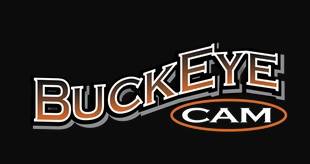
FAQ
Frequently asked questions
Everything you need to know about the BuckEye Cam
Q: Do your cameras require cell service?
A: No. Our cameras transmit images to a base receiver using our own proprietary wireless protocol. There are no monthly fees, and cell service is not needed.
Q: How do the cameras know when to take a picture?
A: The cameras are motion activated. When motion is detected in front of the camera a picture is automatically taken and transmitted to the base. In addition to the motion detection, the cameras may also be set to take time lapse images on a defined schedule.
Q: What is the range of the motion detector?
A: Typically about 100 feet. May be a little more or little less depending on the temperature.
Q: Do the cameras take pictures at night?
A: Yes. The night images are taken with an infrared flash operating at 940nm. This is mostly invisible to the human eye.
Q: How do I view the pictures?
A: The pictures are received at the base. The base is connected to a computer that runs the X-Series Network Manager software app. Using this software, the images can be viewed. They can also be automatically emailed or uploaded to our Livecam web server if desired.
Q: Do the cameras take videos?
A: Yes. The cameras can be set to take pictures, video clips or both. The maximum video length is 30 seconds.
Q: What is the resolution of the pictures and video?
A: The picture resolution is adjustable from 1/3 Megapixel up to 5 Megapixel. The video resolution is adjustable from 640x360 up to 720HD (depending on the camera model).
Q: How do I adjust the settings on the cameras?
A: The settings are adjusted wirelessly using the X-Series Network Manager software.
Q: What settings are available on the cameras?
A: Image / video resolution, delay between motion triggers, motion sensor sensitivity, camera schedule, text on pictures and many more. The best way to find out about all of the settings is to download the X-Series Network Manager software and run it in demo mode.
Q: Does the X-Series Network Manager software work on Windows or Mac?
A: Yes. The software works on both Windows and Mac computers. There is even a Linux version.
Q: You say that up to 254 devices can be registered to one base. What does this mean?
A: When we refer to “device” we are talking about any of our wireless devices. This may be any of our camera models or auxiliary devices. So the total number of cameras and/or auxiliary devices that may be registered to one base is 254. To be “registered” to a base means that the device is assigned to the wireless network that is transmitting to that base.
Q: Can I view pictures on my smartphone?
A: Yes. If you purchase the optional Livecam service, you may use the X80 app on your smartphone to view pictures. You can also choose to receive push notifications when an image is received.
Q: What is the difference between the bases?
A: First it is important to understand what all of the bases have in common. When a camera transmits a picture or video it is received by the base. The base is connected to a computer that is running the X-Series Network Manager software. The primary difference between the bases is HOW they connect to the computer. The simplest base is the PC Base. It connects directly to the computer with a USB cable. Another option is the Cell Base. It connects to a computer via the internet using cell service. The third base option is the Net Base. It connects to a computer over a local private network.
Q: Wait - you said cell service is not required. So, what is the Cell Base?
A: Cell service is NOT required to operate the cameras. The cameras ALWAYS transmit to the base receiver using our own proprietary wireless protocol. However, the base must connect to a computer in some way. If you have a computer within range of at least one wireless device (i.e. camera or Echo), the simplest method is to use the PC Base which connects to the computer with a USB cable. If you do NOT have a computer within range of at least one wireless device, you may want to use the Cell Base. With the Cell Base your computer can be located anywhere in the world and you connect to the base with a cellular internet connection. So, with the Cell Base you will need to purchase a cellular data plan. The good news is that you can connect up to 254 cameras to one base. So you only need one data plan. You do NOT need a data plan for each camera.
Q: How far can the cameras transmit?
A: Transmission distance could be anywhere from 1-2 miles, or up to 15-20 miles, depending on the type of antenna used and also the terrain. The cameras use line-of-sight transmission. Generally speaking, this means that you need to have a limited amount of obstructions between the transmitting and receiving devices in order to get a good signal. It is usually possible to transmit through most types of trees and wooden walls although the signal strength may be reduced. It is usually not possible to transmit through thick pine trees, metal structures or large hills.
Q: What if I need to increase transmission distance?
A: Transmission distance can be increased by using high-gain antennas and/or elevating the antennas. Transmission distance can also be increased using repeaters. The X80 Echo can be used as a repeater. Also any camera may function as a repeater and a camera at the same time.
Q: What is the X80 Echo?
A: The X80 Echo is an auxiliary device that may be used as a repeater to extend transmission distance or as an auxiliary motion sensor to trigger one or multiple cameras. It may also be used to connect to external ground sensors that may be used to trigger the camera.
Q: What is a "hop"?
A: One way to increase transmission distance is to use repeaters. A repeater relays the message from one device to another. Let's say camera A transmits to camera B which then transmits to the base. Each relay (i.e. A to B and B to the base) is called a "hop". For a more detailed description of repeaters refer to Application Note 01: Optional Antenna
Setups for all Buckeye Cam Wireless Devices.
Q: Do the cameras work on batteries?
A: Yes. The cameras use a rechargeable 12V SLA battery. The battery is contained in an external battery pack that connects to the camera with a cable.
Q: How long does the battery last?
A: This depends on how many pictures or videos are taken and how good the transmission signal strength is. Typically you can expect to get about 3000 images or 3 months (whichever comes first) on a single battery charge. You may also connect an optional solar panel to extend battery life indefinitely.
Q: Do you offer setup service?
A: Yes we do. The cameras are user friendly and easy to set-up. Most customers set the cameras up by themselves, but we do offer on-site setup services. If you are setting up a large number of cameras or need assistance with high-gain antennas you may benefit from on-site setup services. Contact our sales department for scheduling and pricing.
Q: Are you GSA approved?
A: Yes. We are a GSA Multiple Award Schedule Contract Holder.
Q: Where are your cameras used?
A: Our products are currently being used all around the world in the most extreme environments. You will find our cameras in the desert, the woods, the mountains, the jungle, even Antarctica!




